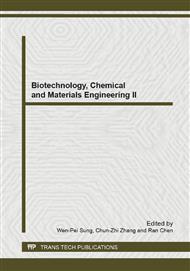[1]
A. Fujishima, K. Honda, Electrochemical photolysis of water at a semiconductor electrode, Nature 238 (1972) 37–38.
DOI: 10.1038/238037a0
Google Scholar
[2]
A. Fujishima, T. N. Rao, D. A. Tryk, Titanium dioxide photocatalysis, J. Photochem. Photobiol. C: Photochem Rev. 1 (2000) 1-21.
Google Scholar
[3]
B. O'Regan, M. Gratzel, A low-cost, high-efficiency solar cell based on dye-sensitized colloidal TiO2 films, Nature 353 (1991) 737-740.
DOI: 10.1038/353737a0
Google Scholar
[4]
G. Wang, Q. Wang, W. Lu, J. H. Li, Photoelectrochemical study on charge transfer properties of TiO2-B nanowires with an application as humidity sensors, J. Phys. Chem. B 110 (2006) 22029-22034.
DOI: 10.1021/jp064630k
Google Scholar
[5]
H. Xu, F. L. Jia, Z. H. Ai, L. Z. Zhang, A general soft interface platform for the growth and assembly of hierarchical rutile TiO2 nanorods spheres, Cryst. Growth & Design, 7 (2007) 1216-1219.
DOI: 10.1021/cg0609419
Google Scholar
[6]
Z. Miao, D. S. Xu, J. H. Ouyang, G. L. Guo, X. S. Zhao, Y. Q. Tang, Electrochemically induced Sol-Gel preparation of single-crystalline TiO2 nanowires, Nano Lett. 2 (2002) 717-720.
DOI: 10.1021/nl025541w
Google Scholar
[7]
T. Kubo, A. Nakahira, Local structure of TiO2-derived nanotubes prepared by the hydrothermal process, J. Phys. Chem. C 112 (2008) 1658-1662.
DOI: 10.1021/jp076699d
Google Scholar
[8]
Y. Kondo, H. Yoshikawa, K. Awaga, M. Murayama, T. Mori, K. Sunada, S. Bandow, S. Iijima, Preparation, photocatalytic activities, and dye-sensitized solar-cell performance of submicron-scale hollow spheres, Langmuir, 24 (2008) 547-550.
DOI: 10.1021/la702157r
Google Scholar
[9]
J. G. Yu, W. Liu, H. G. Yu, A one-spot approach to hierarchically nanoporous Titania hollow microspheres with high photocatalytic activity, Cryst. Growth & Design, 8 (2008) 930-934.
DOI: 10.1021/cg700794y
Google Scholar
[10]
X. X. Li, Y. J. Xiong, Z. Q. Li, Y. Xie, Large-scale fabrication of TiO2 hierarchical hollow spheres, Inorg. Chem. 45 (2006) 3493-3495.
DOI: 10.1021/ic0602502
Google Scholar
[11]
J. Y. Kim, S. B. Choi, D. W. Kim, S. W. Lee, H. S. Jung, J. K. Lee, K. S. Hong, Surfactant-assisted shape evolution of thermally synthesized TiO2 nanocrystals and their applications to efficient photoelectrodes, Langmuir, 24 (2008) 4316-4319.
DOI: 10.1021/la703497e
Google Scholar


